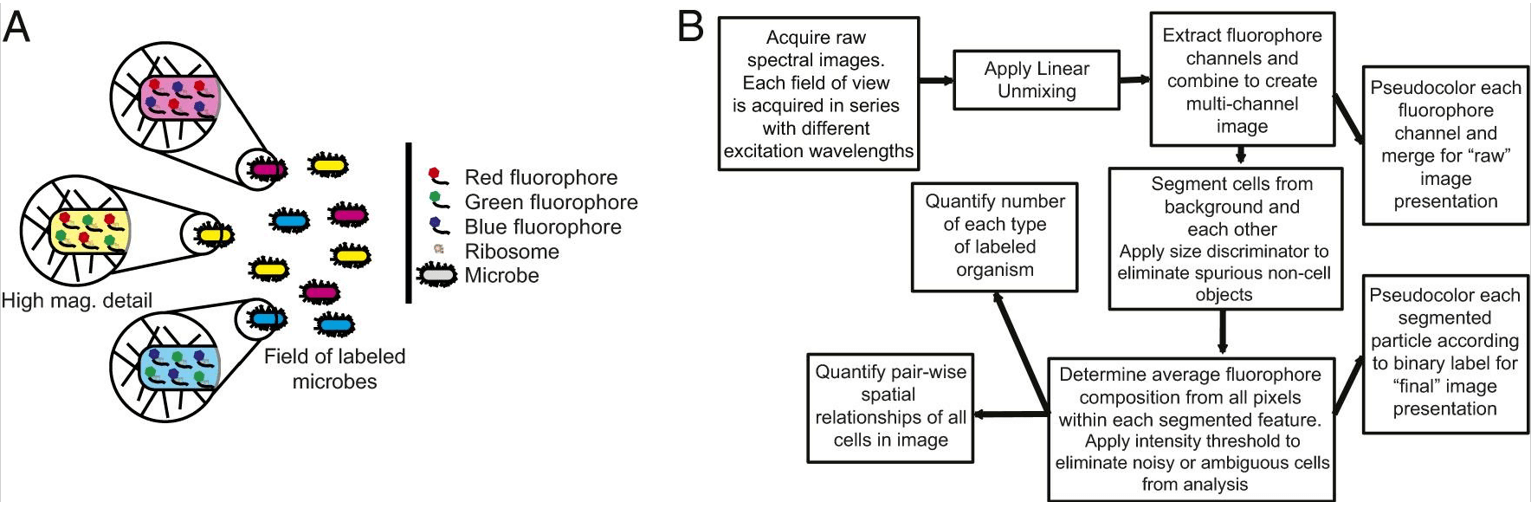Combinatorial Labeling and Spectral Imaging
Modern microbiological research has proved that microorganisms do not live as isolated cells. Microorganisms in nature often function as members of complex and multi-classified communities. This makes it important to analyze the structure and organization of different microbial communities at the micrometer level. At the same time, the composition of this complex microbial community adds difficulty to the identification and analysis of its members. Traditional methods mostly rely on phenotypic characteristics. On the contrary, modern microbial imaging methods no longer rely solely on phenotypic characteristics. The development of FISH technology has brought an important advancement to microbiology or research related to microorganisms. The FISH technology of rRNA-targeted oligonucleotide probes has been developed for the classification, identification and visualization of microorganisms in situ. In theory, FISH probes can design sequence-specific rRNA probes for all microorganisms with whole-genome sequencing data, and are suitable for almost any microbial phylogeny or taxa. The combinatorial labeling strategy requires the use of two or more fluorophores selected from the selected fluorophores to label a given type of microorganism. Based on the combined labeling and spectral imaging method, it has gradually developed to Combinatorial Labeling and Spectral Imaging FISH (CLASI-FISH), which greatly expands the number of different types of microorganisms that can be distinguished in the field of view.
 Fig 1. Overview of the CLASI-FISH method. (Valm A M, et al. 2011)
Fig 1. Overview of the CLASI-FISH method. (Valm A M, et al. 2011)
About CLASI-FISH
Microbes in nature often function as members of complex multi-taxonomic communities, but the microstructural organization of these communities is difficult to analyze due to limitations in labeling and imaging techniques. CLASI-FISH can greatly expand the number of distinguishable taxa in a single FISH experiment, improving the group analysis power of FISH. CLASI technology, combined with spectral imaging dye combinations, allows the use of fluorophores with highly overlapping excitation and emission spectra. So at the heart of the technology is the use of a "combinatorial labeling" approach, in which the same microbial cells are doubled or doubled with different dyes to cause color mixing. Each individual microbial taxa is labeled with a unique combination of two or more distinct single-labeled probes so that the taxa can be distinguished from each other by combining the spectral properties of the fluorophores. Taxonomic groups were then identified by applying a linear decomposition during post-processing of the spectral images.
 Fig 2. FISH assay based on multi-labeled probes produced by combinatorial labeling method.
Fig 2. FISH assay based on multi-labeled probes produced by combinatorial labeling method.
Creative Bioarray is committed to improving the application platform of FISH technology and providing customers with high-quality in situ analysis solutions. Our diverse probe customization service can be used in CLASI-FISH methods. By scientifically and rationally designing a combination of probe markers, the analytical capability of FISH technology is improved. Our probe products go through a series of quality control steps. FISH methods based on multi-labeled probes generated by combinatorial labeling methods can be used to analyze complex microbial communities in scientific research projects. If you have related probe customization needs, please contact us for cooperation. We look forward to cooperating with you in the near future.
References
- Valm A M, Welch J L M, Rieken C W, et al. Systems-level analysis of microbial community organization through combinatorial labeling and spectral imaging[J]. Proceedings of the National Academy of Sciences, 2011, 108(10): 4152-4157.
- Lukumbuzya M, Schmid M, Pjevac P, et al. A multicolor fluorescence in situ hybridization approach using an extended set of fluorophores to visualize microorganisms[J]. Frontiers in microbiology, 2019, 10: 1383.
All products and services on this website are only suitable for non-medical purposes.


 Fig 1. Overview of the CLASI-FISH method. (Valm A M, et al. 2011)
Fig 1. Overview of the CLASI-FISH method. (Valm A M, et al. 2011) Fig 2. FISH assay based on multi-labeled probes produced by combinatorial labeling method.
Fig 2. FISH assay based on multi-labeled probes produced by combinatorial labeling method.


